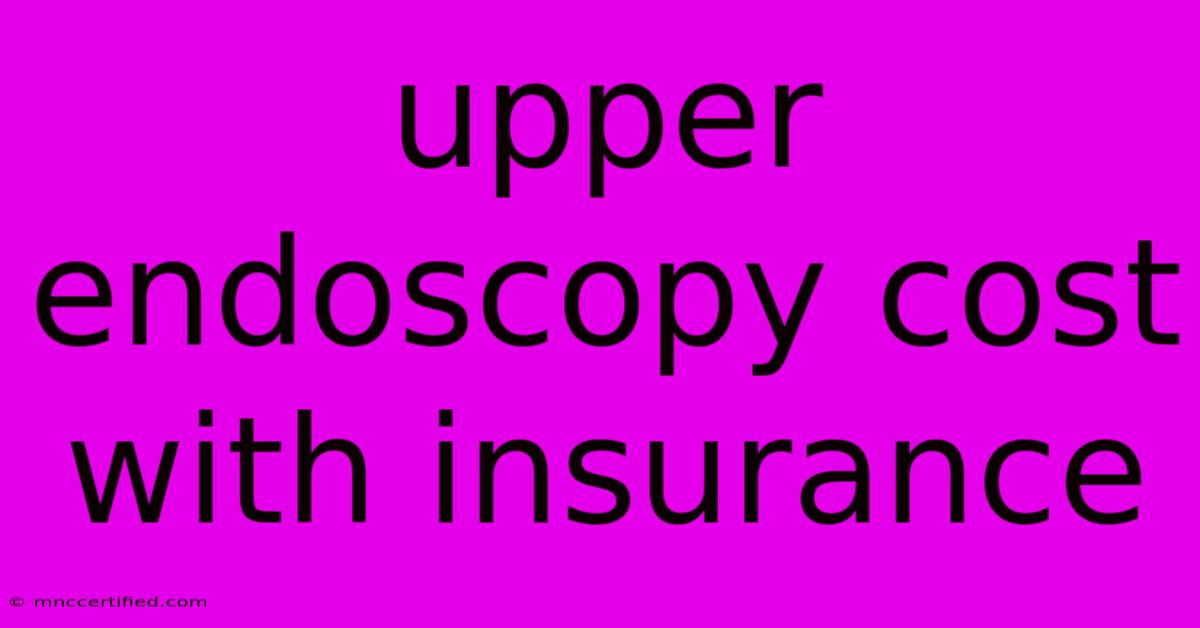Upper Endoscopy Cost With Insurance

Table of Contents
Understanding the Cost of an Upper Endoscopy with Insurance
An upper endoscopy is a common diagnostic procedure used to examine the lining of the esophagus, stomach, and duodenum. It helps doctors diagnose conditions like ulcers, gastritis, and even cancer. While it's a valuable tool, the cost of an upper endoscopy can be a concern, especially with the complexities of insurance coverage. This article will break down the factors influencing the cost of an upper endoscopy and how your insurance plan might impact it.
Factors Affecting the Cost of an Upper Endoscopy
The cost of an upper endoscopy can vary depending on several factors:
- Location: Costs can vary significantly based on the geographic location of the procedure.
- Facility Type: Performing the endoscopy in a hospital setting will typically be more expensive than an outpatient clinic or doctor's office.
- Anesthesia: Whether the procedure is performed under sedation or general anesthesia will affect the overall cost.
- Complexity of the procedure: Additional procedures, such as biopsies or polyp removal, will increase the cost.
- Out-of-pocket expenses: Co-pays, deductibles, and coinsurance can add to the total cost even with insurance.
Understanding Your Insurance Coverage
Knowing what your insurance covers is crucial when considering an upper endoscopy. Here's what you need to know:
- Deductibles: This is the amount you must pay out of pocket before your insurance starts covering costs.
- Co-pays: A fixed amount you pay for each service, like a doctor's visit or procedure.
- Coinsurance: A percentage of the cost you pay after your deductible has been met.
- Coverage Limits: Some insurance plans have annual limits on what they will cover for procedures.
Ways to Manage the Cost of an Upper Endoscopy
Here are some tips to potentially manage the cost of your procedure:
- Check your insurance coverage: Before scheduling the procedure, contact your insurance provider to understand your coverage details, including deductibles, co-pays, and any pre-authorization requirements.
- Consider a less expensive facility: Ask your doctor if they perform upper endoscopies in their office or at a less expensive facility.
- Explore payment plans: Some clinics offer payment plans to make the procedure more affordable.
- Compare costs: Get quotes from different healthcare providers to compare costs before making a decision.
- Look for discounts: Some clinics may offer discounts for cash payments or have financial assistance programs available.
Conclusion
The cost of an upper endoscopy can vary significantly, but understanding the factors affecting the price and how your insurance plan works can help you make informed decisions. By taking the steps outlined above, you can potentially manage the cost and access the necessary medical care without undue financial burden. Always consult with your doctor and insurance provider to ensure you understand your options and available resources.

Thank you for visiting our website wich cover about Upper Endoscopy Cost With Insurance. We hope the information provided has been useful to you. Feel free to contact us if you have any questions or need further assistance. See you next time and dont miss to bookmark.
Featured Posts
-
Hawks Vs Celtics Tatums Status For Tonight
Nov 13, 2024
-
Leslie Uggams Discusses Deadpool And Wolverine Mcu
Nov 13, 2024
-
Rubios Shift Embracing Trumps Foreign Policy
Nov 13, 2024
-
Trump Picks Huckabee For Israel Role
Nov 13, 2024
-
Factory Collapse In Kentucky After Explosion
Nov 13, 2024